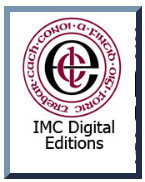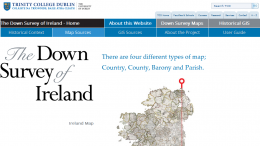More 17th century Irish history online: the Civil Survey 1654–6
Next » « PreviousThe Civil Survey 1654–6 of landholding in Ireland was carried out by an inquisition which visited each barony and took depositions from landholders based on parish and townland, with written descriptions of their boundaries. The Survey covered 27 of Ireland’s 32 counties, but excluded the five counties in Connacht which had been the subject of the Strafford survey commissioned by Thomas Wentworth, 1st Earl of Strafford in the 1630s. The original Civil Survey records were destroyed by fire in 1711, but a set of copies for ten counties was discovered in the 19th century.
 The Survey was published by the Irish Manuscripts Commission in the early 20th century and digital copies are now available. Of most interest in connection with the Great Parchment Book and the Ulster Plantation is the Survey for Donegal, Londonderry and Tyrone originally published in 1937. The digital copy of the published copy is available here.
The Survey was published by the Irish Manuscripts Commission in the early 20th century and digital copies are now available. Of most interest in connection with the Great Parchment Book and the Ulster Plantation is the Survey for Donegal, Londonderry and Tyrone originally published in 1937. The digital copy of the published copy is available here.
 The Civil Survey was separate from the Down Survey, a cartographic survey, which began while the Civil Survey was in progress, and made use of Civil Survey data to guide its progress. The Down Survey is also available online. Find out more about the Down Survey of Ireland in a previous blog post on 17th century Irish history online.
The Civil Survey was separate from the Down Survey, a cartographic survey, which began while the Civil Survey was in progress, and made use of Civil Survey data to guide its progress. The Down Survey is also available online. Find out more about the Down Survey of Ireland in a previous blog post on 17th century Irish history online.
4 thoughts on “More 17th century Irish history online: the Civil Survey 1654–6”
Leave a Reply
You must be logged in to post a comment.
Since Adobe Flash Player is no longer supported is there another way to view the Survey for Donegal, Londonderry and Tyrone?
Thank you for pointing this out Joe. I will investigate whether there is an alternative way of investigating the Irish Manuscripts Commission digital editions and amend the page accordingly.
The digital editions are now available as PDFs. I will amend the link accordingly. In the meantime, you can view the PDF here https://www.irishmanuscripts.ie/digital/The%20Civil%20Survey%201654%20Vol%20III%20Co%20Donegal/The%20Civil%20Survey%201654%20Vol%20III%20Co%20Donegal.pdf
Thank you, Philippa!